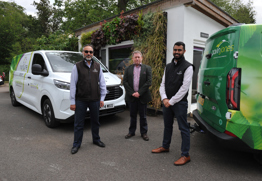3M has a fleet of some 800 company cars used by a team of 400 sales people plus managers who receive a car as part of their remuneration package.
Some 10 million business miles are driven annually by 3M employees in the UK and Ireland. In a typical year there are approximately 140 incidents involving 3M vehicles, with an average repair cost of £890.
In the past five years 23 incidents resulted in injuries to 3M employees. There were no fatalities.
Organisational structure
In the UK and Ireland 3M serves customers through seven business segments, which increase speed and efficiency by sharing technological, manufacturing, marketing and other resources.
Work-related road safety policy and procedures
In July 2008 3M called an end to its employees’ use of mobile phones while driving.
Employees were briefed not to use their phones, even hands-free, unless their cars are stationary with the handbrake on.
The decision followed advice from leading safety advisers and groups such as the Royal Society for the Prevention of Accidents (RoSPA) and TRL, the UK's leading transport research laboratory.
RoSPA figures show that drivers are four times more likely to be involved in an accident if they are using a mobile phone on the road.
Announcing the ban, 3M’s Managing Director Doug Mitchell wrote to employees:
“There has been a growing bank of compelling evidence that using even hands-free phones affects various aspects of driving performance. Our employees’ welfare and safety is paramount to 3M – we have an outstanding record when it comes to the prevention of work place accidents – and we are fully committed to keeping that record whether our employees are on 3M premises or on the move.”
The ban covers all employees whether they are driving company cars or using their own vehicles on business.
3M also provides a ‘defensive driving’ training course for its 800 company car drivers. A combination of desk based training and practical assessment in the driver’s vehicle help them to better understand their own attitudes to driving, and enable them to identify and address areas of poor practice, reducing the risk of a crash. Training is repeated every four years. Participation levels are, at the time of writing, 92 per cent.
Specific examples of procedures
Announcing the ban, employees were advised that, as the use of mobile communication has increased over the years, there was growing evidence that using even hands-free mobile phones affects various aspects of driving performance. Research suggested that the use of hands-free phones has been a contributory element in a number of accidents resulting in fatalities or serious injury.
Employees were told that, having considered all the information and advice received, the senior management team had decided with immediate effect to ban the use of mobile phones while driving.
Employees making calls to colleagues’ mobile phones were asked to check that the person receiving the call was not driving before continuing with the call. If they were, they should ask them to call back when the car is stationary and the handbrake on.
The senior management team fully recognised that this new policy would, for some people, require changes to their standard way of working. For this reason the company consulted with a group of employees to identify any particular difficulties and understand what might be done to help.
Auditing and review
3M routinely explains the reasons for policy decisions to employees because the company believes that, armed with an appropriate level of understanding, employees will be more inclined to comply with those policies. We have no plans to marry call data with employees’ driving times in order to monitor compliance, as this would be strongly counter-cultural in an organisation employee empowerment is considered central to our success.
Our communications programme is designed to win hearts and minds through education - with the repetition and reinforcement of messages over time. Critically, communication is two-way, with the company being open to discussion and debate and being willing to be flexible in the light of well reasoned argument.
As a result of employee consultation two policy changes were made. At first, employees were told that phones should be turned off while they were driving. However, this caused considerable anxiety to a number of drivers who wished to know if someone was trying to contact them. This could be for personal reasons (people with young families or sick relatives) as well as business reasons. This led to a review of the policy to say that phones could be switched on - but not used while driving.
Also, initial company guidance was that vehicles should be parked and engines switched off before calls could be made or received. Feedback highlighted the fact that this would impact on heating or air conditioning while drivers were parked to make calls and, as a result, the policy was amended to say that cars need to be parked and the handbrake applied before using a mobile phone.
Performance measures
Employee attitudes are being monitored. A survey conducted three months after the ban was introduced indicated a swing in employees’ attitude. When the ban was first introduced, 56 per cent of staff did not welcome it. Just three months later, less than half (41 per cent) said they did not like it.
The survey (which was anonymous) showed 59 per cent of employees complying fully; 38 per cent 'most of the time' and 3 per cent ignoring the policy.
The results showed real signs that the safety message was getting through. When asked their reasons for complying with the new rules, 45 per cent said it was because they thought using a mobile phone while driving was a dangerous distraction and could lead to an accident.
The survey also indicated that the ban had tracked through to 3M employees’ personal lives. 43 per cent said that they already avoided using their personal phone while driving – but since the work ban a further 42 per cent had either stopped or reduced the practice.
The survey also found that almost three quarters of employees said that customers had either welcomed the ban or had been neutral about its introduction, allaying some of the fears about potential reactions.
Accident reduction
The ban was introduced proactively as a preventative measure - not as a reaction to incidents involving 3M drivers. ‘Before and after' crash statistics are being monitored, but more time will need to pass before a meaningful analysis can be undertaken.
Financial and other benefits
Just a few months after the introduction of the ban, it is too soon for us to be able to assess any changes in accident rates. But other benefits are already apparent – particularly in the form of PR, employee engagement and company reputation.
As a sponsor of Road Safety Week, an annual event organised by Brake, the road safety charity, 3M also encourages active employee involvement in road safety matters, with workplace events such as crash rescue demonstrations from local fire brigades and community-based awareness raising activities.
Road safety has been high on our agenda for a number of years. However, we recognise that the way a company acts is every bit as important as the causes it supports – and our ban is evidence of that belief being put into action.
Also, within the wider 3M company, other 3M subsidiaries are now studying the UK's approach to this topic, with 3M France being the first to follow our lead and introduce a similar ban.
Isolating the impact of the ban on employees’ general perceptions of the company is difficult to do. However, we monitor employees’ perceptions of the company regularly, as employee engagement is recognised as key to the company’s success. Results from our September 2008 Employee Opinion Survey showed agreement with the statement ‘I am proud to be a 3M employee’ to be standing at 81 per cent, with a further 14 per cent neutral.
Child road safety has been the main focus of 3M’s community programme in the UK and Ireland since 2005. In that time the company has donated more than 100,000 high visibility reflective vests to school children local to 3M sites throughout the country and also funded an education in science theatre company to visit primary schools with a play about road safety. A new web based teaching resource – www.3Mstreetwise.co.uk - was also introduced in October 2006.
Lessons learned
Recognising the ban was attracting interest from other companies, 3M conducted a driver distraction survey during November and December 2008, receiving 1,638 responses from drivers up and down the UK, 1,048 of whom who used their cars on business.
The survey’s findings suggested that business worries could be leading drivers to use their phones in the car even though they know it puts them at higher risk of an accident.
Some 62 per cent of motorists who took part in a national survey realised that talking on a hands-free phone makes a crash more likely and more than a quarter said they knew somebody who had had an accident or a near miss while using a hands-free in the car.
But six out of ten feared that if they stopped talking on the move it could have a negative effect on their business. Some 21 per cent felt they had to be contactable at all times.
Professor Andrew Parkes, Chief Research Scientist at TRL was quoted in the press release announcing the survey’s findings, saying: “At some stage, I fully expect to see an employer sued by an employee involved in an accident due to being distracted by a business call while driving.”
Current and future developments
3M is committed to doing business in the right way, a value that is evident in all aspects of our operations. Introducing this ban was both difficult and easy. It was difficult because the senior management team was fully aware of the effect it would have on the working practices of so many employees – and the potential consequential impact on business. However, presented with compelling evidence of the dangers, it was, ultimately, an easy decision to make.
We recognise that the topic of using hands-free phones while driving has become a matter of debate amongst companies - with many organisations approaching 3M to share our experience, which we do willingly.
We are also committed to repeating our employee survey 12 months after the first in order to continue monitoring perceptions of the ban and will again make the findings publicly available.



















Login to comment
Comments
No comments have been made yet.